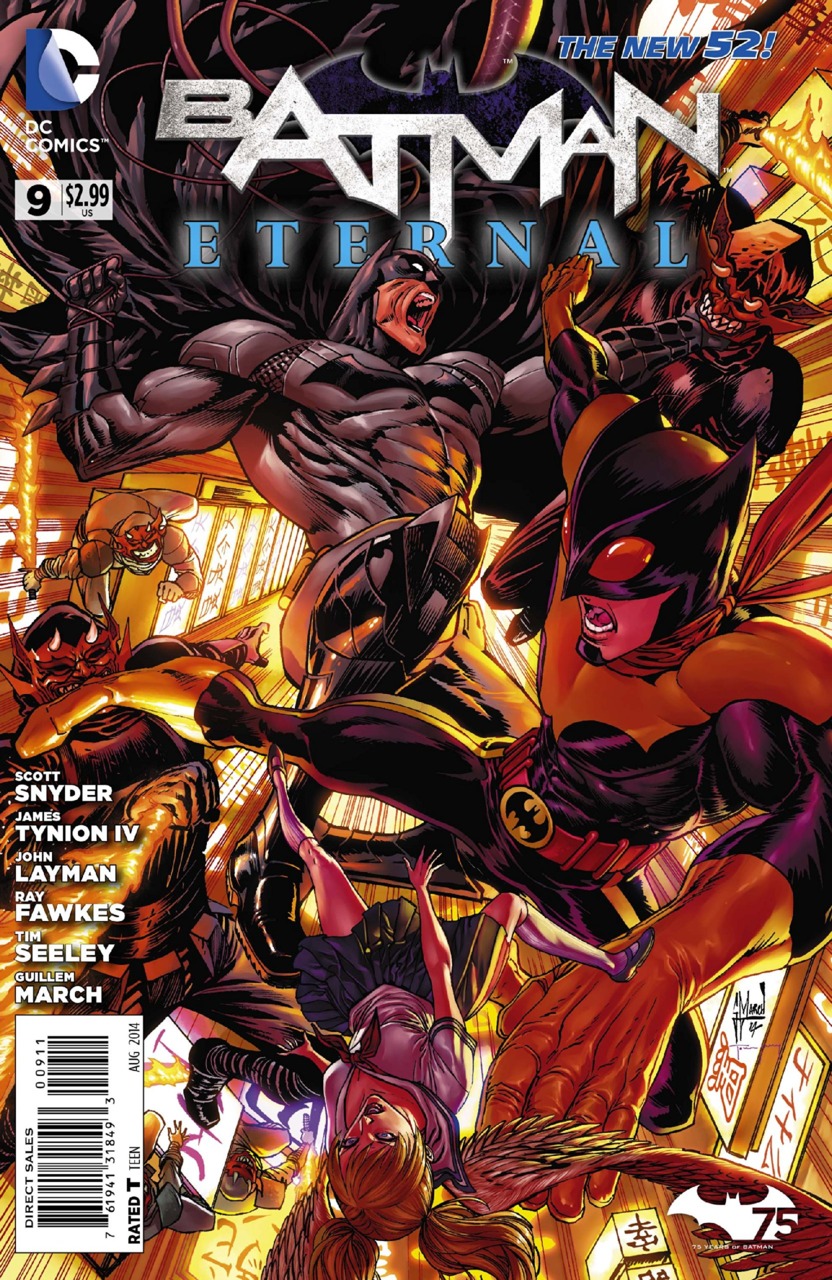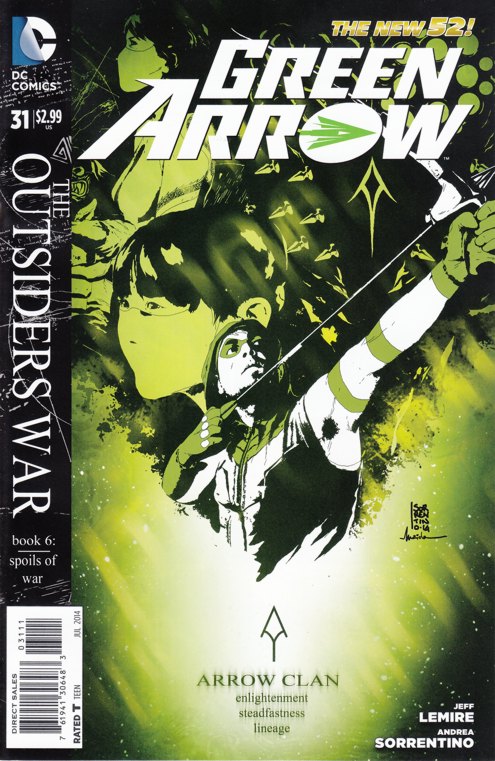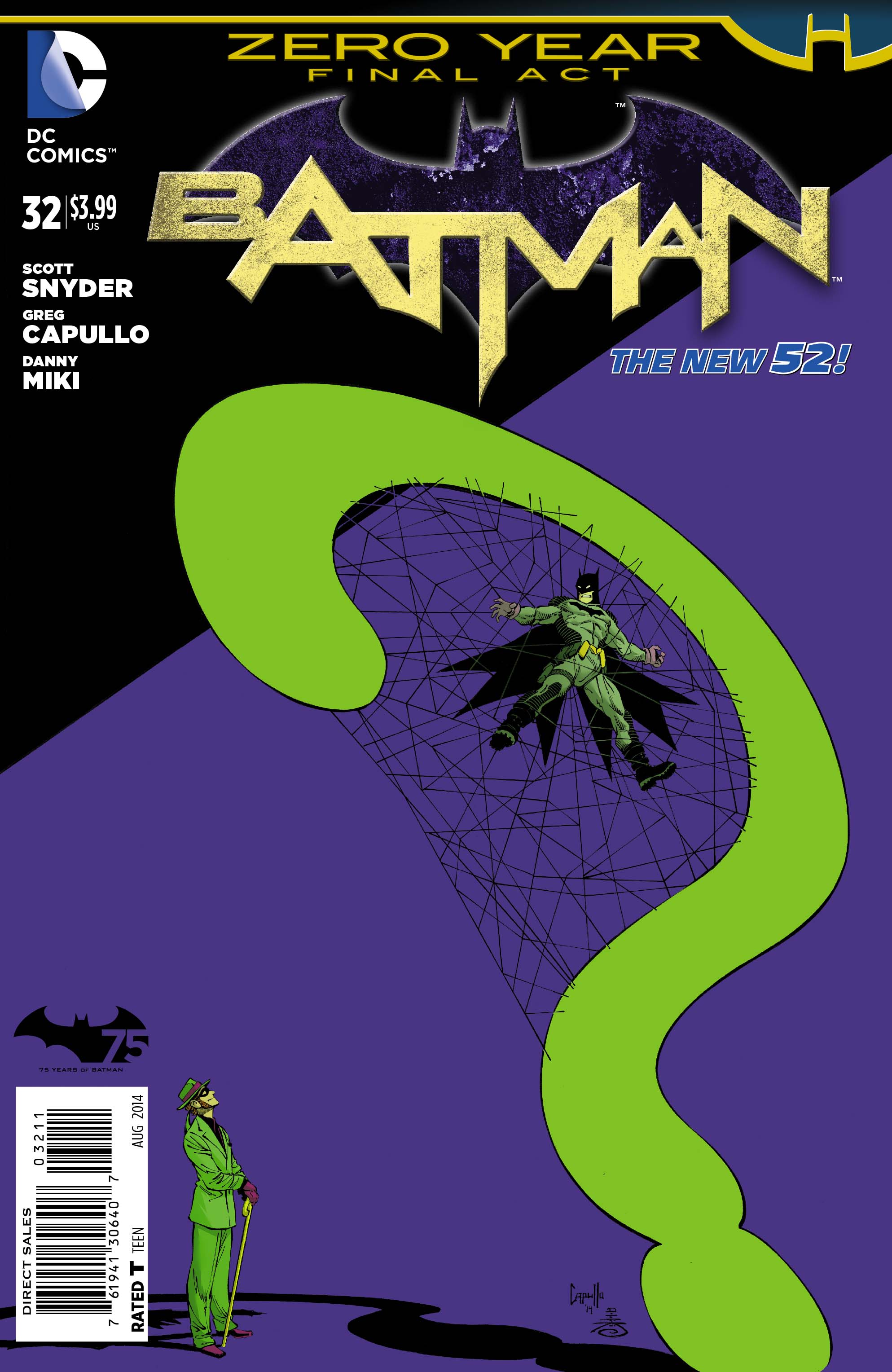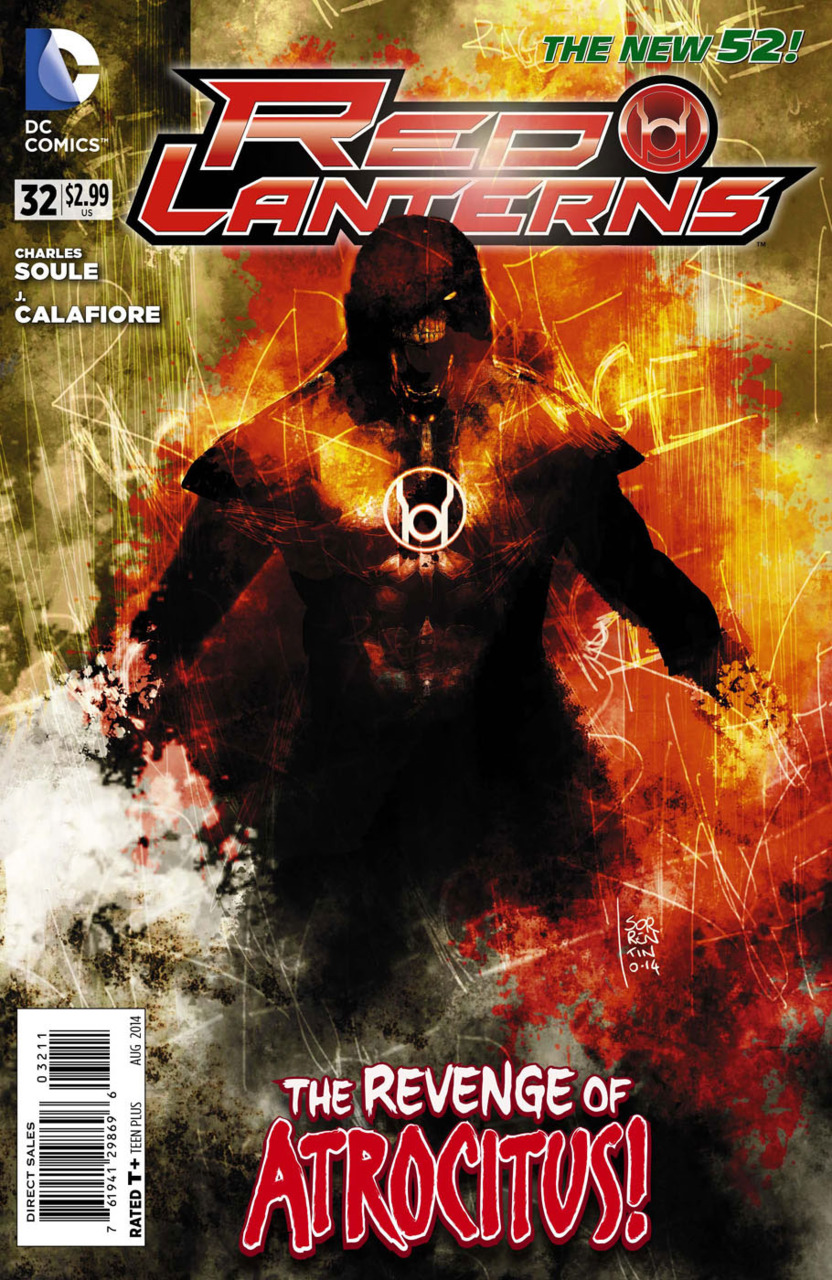Mild-mannered reporters by day, Greg Phillips and Nick Duke share an intense love of comic books that has made them the Hard-Traveling Fanboys. And if there’s anything that fanboys love, it’s debating what book is better than another book or which character is “cooler.” Enter Countdown, a monthly column where Greg and Nick will give a top five list and debate the merits therein.
Greg: Welcome to the first Hard-Traveling Fanboys column of 2015! We hope you enjoyed your holidays and enjoyed New Year’s more than I did while watching my beloved Crimson Tide lay an egg in New Orleans.
Nick: Or more than I did watching my miserable Atlanta Falcons inexplicably find themselves in the midst of the playoff hunt only to get blown out by a mediocre Carolina team.

But this isn’t the Hard-Traveling Football Fans, it’s the Hard-Traveling Fanboys, and we’re here to talk about comics, not sports. Specifically, we’re here to reveal our favorite ongoing comic books of the year that was 2014.
Greg: Indeed, last year was a strong one in the industry, with several new, fresh takes on existing properties and even more original successes, many of which I’ve unfortunately not been able to read yet (look for some of them to pop up in The Longbook Hunters down the line). From fresh takes on icons to new characters inheriting familiar roles, from legendary creators crossing company lines to modern-day superstar teams winding to an end, it was a great year to be a fan of the funnybooks.
Without any further adieu, let’s get a look at Nick’s fifth-place pick for best ongoing of the year.
Nick’s No. 5: Miles Morales: The Ultimate Spider-Man
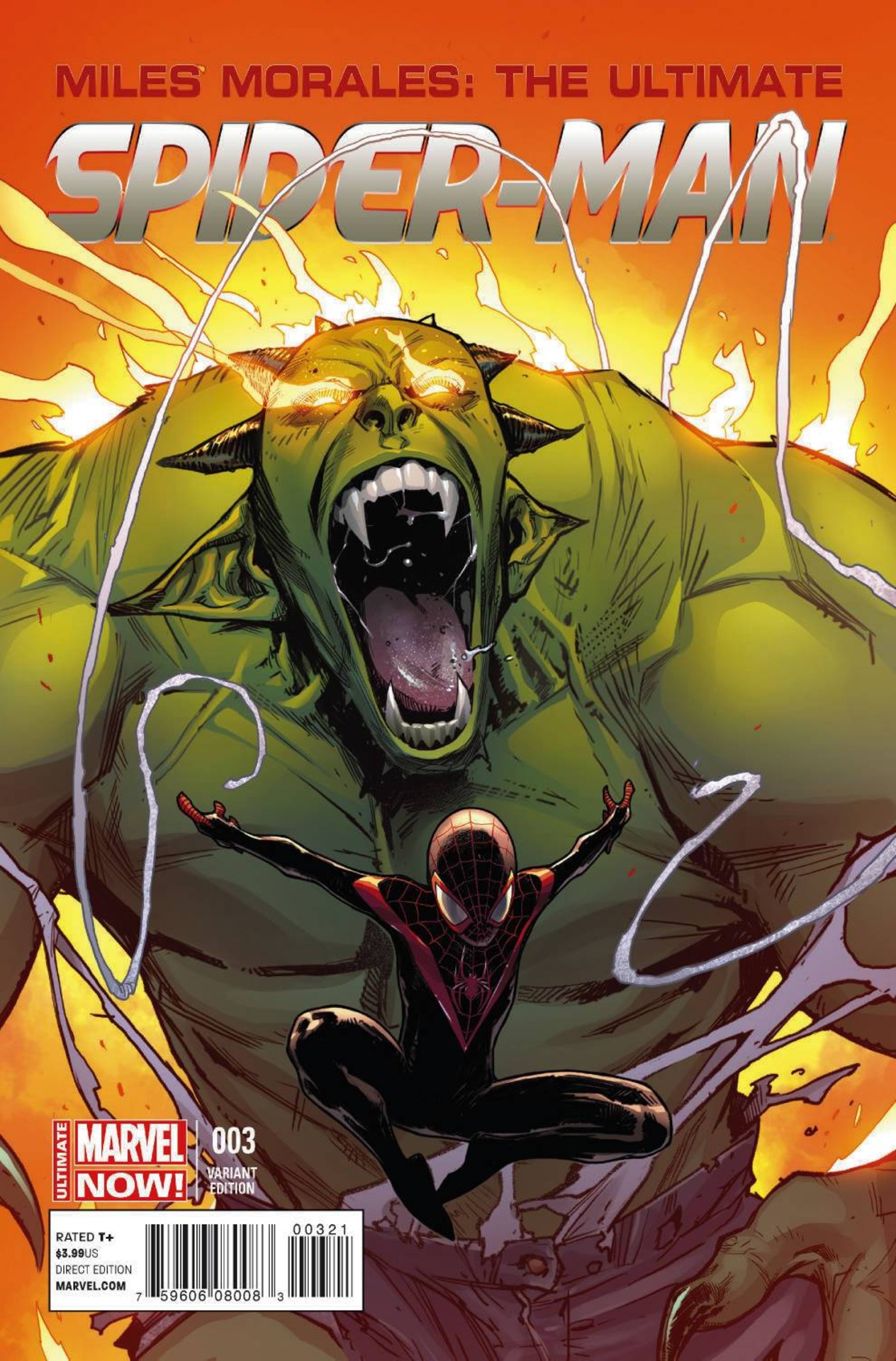 Greg: Brian Michael Bendis has shepherded the Spider-Man side of the Ultimate Universe from its inception, and original creation Miles Morales has stepped up to carry his own title in a strong manner.
Greg: Brian Michael Bendis has shepherded the Spider-Man side of the Ultimate Universe from its inception, and original creation Miles Morales has stepped up to carry his own title in a strong manner.
Nick: I’ve expressed my love for Brian Michael Bendis’ nearly 15-year work in the Ultimate universe many times before, but even I had fallen out of touch a bit during the initial days of Miles Morales’ tenure as the new web-slinger. I slowly caught up over the last year, however, and when Bendis penned the crossover event Ultimate Cataclysm, it seemed as if the entire universe might be coming to an end. That didn’t happen, but it did usher in yet another series of relaunched titles with new No. 1 issues. Of those, I decided to try out Miles Morales, and I have not been disappointed.
Though technically a separate series, the story really starts with Ultimate Spider-Man 200, an issue that served as a bridge between the old Peter Parker-led series and the Miles Morales run. It was the last solo issue released before the start of this new series, and it set up the big mystery that would dominate the book’s first year — Has Peter Parker returned from the grave? The answer would seem to be yes, though not all questions have been answered yet and there still seems to be more to Peter’s return than meets the eye.
And if all the book had to offer was Peter’s return, it would be a fine book. But, the fact that Bendis is able to bring back such a beloved character without ever making Miles feel overshadowed in his own title is truly remarkable. Peter may be back, but this is still undoubtedly Miles’ story. Peter’s return is viewed through Miles’ eyes, and we see how his return affects Miles more than any other preexisting side character. In the end, it shows that even with Peter back, there’s more than enough room for two Spider-Men in this universe.
Throw in some truly fantastic art by David Marquez that seems to be a blend of the styles of Mark Bagley from the Peter Parker run and Sara Pichelli from the initial Miles Morales series, and you’ve got the makings of another worthy addition to the Ultimate Spider-Man legacy.
Greg: Sadly, I’m still working my way through the early Ultimate Spider-Man trades, so I’m only more than a decade behind. But I do look forward to catching up and seeing the universe Bendis and company have built around Ultimate Peter and, now, Miles.
Greg’s No. 5: Southern Bastards
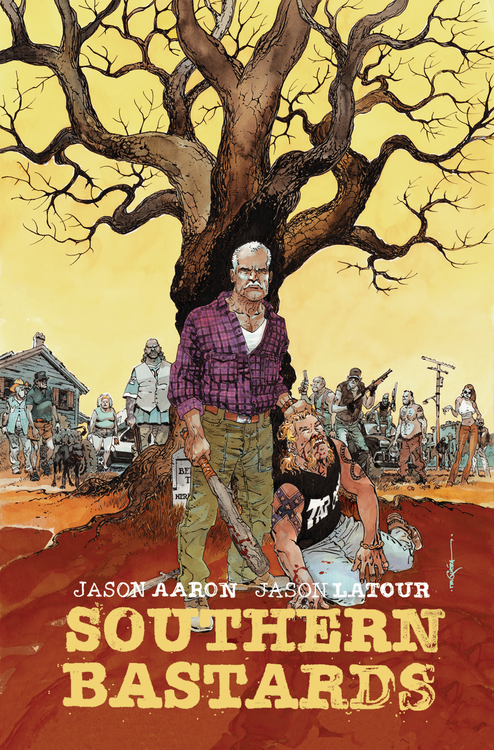 Nick: This one is on my to-read list, as I’m slowly developing a bit of a man crush on one Jason Aaron.
Nick: This one is on my to-read list, as I’m slowly developing a bit of a man crush on one Jason Aaron.
Greg: If you’ve ever wondered what it would be like if the Coen Brothers directed a remake of Walking Tall starring Grizzled Old Man Clint Eastwood, Southern Bastards is the book for you. Alabama native Jason Aaron and fellow southerner Jason Latour introduced this southern-fried revenge story this year for Image Comics, and though it’s only been around a short while, it has made a strong impression on me.
Going into it, I was concerned. Too many times I’ve seen pop culture produced outside the South make easy, lame jokes about the region and its people. Luckily, Aaron balances the critique of southern culture with plenty of love and reverence. Barbecue and football rule the roost down here, and Aaron and Latour capture that beautifully. In fact, one of the biggest draws for me is the fact that this is the first comic I’ve ever read that depicts football accurately. It isn’t movie football, it’s actual football, with real playcalling and things like audibles.
But at its heart, Southern Bastards is an old-fashioned action flick about good vs. evil. In this case, Earl Tubbs is our hero, a grizzled old man returning to the city of his youth for what he thinks is a brief sojourn. As it turns out, like southern comic heroes before him (think Jesse Custer), Earl’s own moral compass draws him into conflict with the larger-than-life football coach who rules the town (a sort of hybrid between Bear Bryant, Nick Saban and the head coach from Varsity Blues).
The result is a story that is instantly engaging and, though early in its run, certainly feels like a classic in the making. If Aaron and Latour can continue this momentum throughout 2015, this book has a strong chance of landing atop my list next year.
Nick: As I said, it’s one I plan on checking out very soon.
Nick’s No. 4: Green Arrow
 Greg: My top book from a year ago continued its dominance through the first half of last year before Jeff Lemire and Andrea Sorrentino sadly walked away. Luckily, the new creative team has done a pretty solid job picking things up and going in their own direction.
Greg: My top book from a year ago continued its dominance through the first half of last year before Jeff Lemire and Andrea Sorrentino sadly walked away. Luckily, the new creative team has done a pretty solid job picking things up and going in their own direction.
Nick: Let’s get this out of the way first: There’s nothing wrong with the current incarnation of the Green Arrow ongoing series written by Ben Sokolowski and Andrew Kreisberg. It’s attempting to bring the comic version of Oliver Queen more in line with the version seen on the hit TV show Arrow. It’s a fairly entertaining superhero story, but if 2014 had been all Sokolowski and Kriesberg, Green Arrow likely wouldn’t have made my cut.
No, it’s the conclusion to an absolutely amazing run by Jeff Lemire and Andrea Sorrentino that earns the spot. In 2014, Lemire and Sorrentino not only wrapped up their amazing Outsiders War storyline, but also ended their run with an all-too brief story that saw the mainstream comics debut of John Diggle, the reintroduction of Richard Dragon and the continued emergence of Emiko Queen as one of the great breakout characters in comics over the last few years. Throw in probably the best of all the Futures End one-shots that served as a fantastic coda to the pair’s run and you have a series that was consistently among my most anticipated each month.
“The Outsiders War” was easily the best series of issues the series has seen since its New 52 debut, and might be the best Green Arrow story since the days of Mike Grell. In fact, I’d say this run by Lemire and Sorrentino would rank right up there alongside Grell and Kevin Smith as my favorite Green Arrow runs of all time. Sorrentino, in particular, has cemented himself as easily one of the top two artists to ever draw the emerald archer, and as blasphemous as it might be to some, he might even be a nose ahead of Grell in my book. His style is innovative and beautifully detailed. His ability to convey motion from panel to panel by using unique layouts was simply amazing. And Lemire captured the voice of this new Oliver Queen better than any writer before or since. Ollie finally felt like a fully realized character separate enough from his pre-New 52 counterpart to justify the difference in appearance, yet familiar enough to remind readers that deep down, the two versions are made up of the same core values and motivations.

I was heartbroken to see the run end, but for any fans out there looking for a great Green Arrow story to sink their teeth into, I highly recommend tracking down the 18 issues Lemire and Sorrentino produced. You won’t regret it.
Greg: I’m going to save most of my thoughts on this title for a little later in Countdown, but let me piggyback off your comments on Lemire and Sorrentino. No superhero book on the stands better represents a team effort than did Lemire and Sorrentino’s Green Arrow. Each page, each panel, each element was important to the overall story. Lemire’s words and Sorrentino’s storytelling were pitch-perfect throughout the run, and they pulled a John Elway, retiring on top of the world rather than allowing their story to finish on a sour note.
Greg’s No. 4: Superman
 Nick: This one narrowly missed my list, as I didn’t start reading until Geoff Johns took over the book, and his run is still in its infancy.
Nick: This one narrowly missed my list, as I didn’t start reading until Geoff Johns took over the book, and his run is still in its infancy.
Greg: This choice is solely based on the book’s soft relaunch by Geoff Johns and John Romita Jr., who took over around mid-year. It gave a stale title a much-needed revamp, shedding the fat of the heavily Krypton-based run by Scott Lobdell and starting from scratch on the original superhero.
Romita Jr. was a huge catch for DC, as he’s an already legendary artist who has always been associated with Marvel Comics, particularly Spider-Man. Expectations were high for this one, and Johns needed to deliver a story worth Romita’s reputation.
Luckily, the two men delivered. Johns has always been best at cutting to the core of existing characters and finding ways to make them shine in a modern context. With Superman, he focuses more on what makes him, well, a man and not a god. Instead of dealing with alien politics, the initial story from Johns and Romita dealt with the isolation associated with being Superman. After all, even the most powerful person on the planet gets lonely once in a while. In Ulysses, we see another in a long line of Superman stand-ins, yet one that feels different in a lot of ways. The story of bonding, friendship, alienation and family that forms the crux of Johns and Romita’s tenure on the book (thus far) has given it a sense of importance and timelessness that has been lacking in many New 52 Superman books.
Romita, who I’ve never been a huge fan of, has knocked this project out of the park, packing every panel with so much energy it’s impossible to ignore. Johns writes Clark as well as anyone in modern comics, and he smartly brought back some of the classic elements of the Superman mythos that have largely been put on the backburner in recent years — Perry White, Jimmy Olsen and the Daily Planet, for instance. Johns also seems to be making a subtle statement about the editorial decision to kill Clark’s parents early in his New 52 life. A particular highlight of the book in 2014 was the tearjerking reunion between Ulysses and his parents.
Superman is one of those franchises that needs to be good. With different takes for different fans — from Greg Pak and Aaron Kuder’s acclaimed Action Comics to Scott Snyder and Jim Lee’s action-packed Superman Unchained, which recently wrapped up — it’s the best time in close to a decade for fans of Big Blue.
Nick: I agree with all of this — this book and Unchained have been able to do something I never thought possible in bumping Superman titles not only onto my pull list, but among my most anticipated pulls each month.
Nick’s No. 3: Batman Eternal
Greg: Though I was only able to read the first 15 issues of this weekly before I tapped out (due solely to financial reasons), it was among my most anticipated reads each week during that run. It’s the first time in the New 52 we’ve really had a chance to explore Gotham outside the primary Bat Family members. And it gives much-needed emphasis to some of the neglected members of the family, like Batwing, Red Hood and reintroduced fan favorite Stephanie Brown.
Nick: While I initially disregarded the entire idea of Eternal as a blatant cash grab by DC, the project has wowed me from the getgo with its wonderful storytelling. Scott Snyder is the head of a bevy of rotating writers, each with a focus on a different subplot throughout the book’s tenure. The truly great thing about Eternal is that it’s the kind of Batbook I’ve wanted for a long time. We have the main title that focuses mainly on Bruce and we have Batman and Robin to focus on Bruce and Damian’s partnership, while the other Bat-titles focus on the various exploits of the various individual characters. Sure, they may pop in for a crossover from time to time, but it’s become increasingly rare to see the Bat Family working alongside one another and interacting in ways besides everyone being mad at Bruce.
Eternal, however, changes all of that. It focuses on nearly every major Batman character, and establishes exactly how each character interacts with one another. It also does a fantastic job of expanding the balloon, so to speak, by furthering our exposure to new characters like Harper and Cullen Row or by bringing Jim Corrigan and the Spectre to Gotham City. The project really feels like a love letter to all things Batman, even bringing back long-lost fan favorite villains such as Carmine Falcone and Deacon Blackfire.
All of this takes place against the backdrop of a truly outstanding mystery story that has seen a shadowy figure putting together a yearlong plan to destroy not only Gotham and Batman, but the lives of all he holds dear. We’ve already seen Jim Gordon jailed, Alfred institutionalized and a wedge driven between Bruce and Catwoman. Along the way, we’ve gotten numerous red herrings as to the true mastermind, with the big bad yet to be fully revealed. There are 12 issues left in a series that has already dropped 40 glorious installments on us, but it feels like just yesterday I was delving into No. 1. It’s made a yearlong weekly breeze by, and that’s a testament to the book’s uncanny ability to always leave you waiting anxiously for the next pages to be in your hands. This goes without saying, but it’s a project every true Batfan should be reading.
Greg: One of the aspects I most enjoyed about the issues I read was just how different the subplots were in style and tone, while remaining appropriate for a Gotham-based story. Snyder’s Batman almost serves as the big-picture framing device while allowing the other writers to experiment and do different things with these diverse characters.
Nick: Well said, sir.
Greg’s No. 3: Green Arrow
Nick: I’ve said my piece about this fantastic series, so I’ll get out of Greg’s way here.
Greg: We focused earlier on the creative team of Jeff Lemire and Andrea Sorrentino, so I’ll focus here on some of the specific ways their 2014 stories worked. First, we saw a tremendous exploration of original characters — namely the new Outsiders and Emiko Queen, Oliver’s long-lost little sister. She’s spoiled, immature, petulant, deadly, cold-blooded … and incredibly entertaining. If Hit-Girl and Damien Wayne had a love child, it would be Emiko.
The Outsiders presented a very real, very dangerous threat to Oliver and his makeshift crew, and seeing that story wrap up — along with the many shocking reveals that accompanied it — stands as one of the biggest highlights of 2014. Yet the creative team also took its turn reintroducing some legendary DC characters in the Clock King and especially Richard Dragon. Their bold reimagining of Dragon from a kung-fu hero to a butt-kicking street lord was the lynchpin of their followup story to “The Outsiders War.” It reinvigorated a decades-old character and felt a bit like the way Denny O’Neil and company introduced Bane in the early 1990s, but without ripping anything off.
Then, of course, there was the introduction of John Diggle from the Arrow TV show, a welcome addition to the Green Arrow mythos. If the new direction ends up half as memorable, compelling and entertaining as Lemire and Sorrentino’s run, Green Arrow fans should rejoice.
Nick’s No. 2: Batman
Greg: Scott Snyder and Greg Capullo’s iconic take on the Dark Knight didn’t miss a beat in 2014. In fact, I’d argue it was even better than it was the year before.
Nick: I had all but made up my mind to give Batman Eternal the No. 2 spot on my list. However, that was up until a few days ago when I was finally able to sit down and read the final Batman issue of 2014, the third chapter of “Endgame,” which is the latest epic story from Scott Snyder and Greg Capullo. That issue was so good, so eerie and terrifying, that it gave Batman the late nod.
But Batman has been far from a one-issue wonder in 2014. Snyder and Capullo gave us the bold reimagining of Bruce’s early days in the cape and cowl with “Zero Year.” The idea of the story was mocked by many when first announced, but by the end of the 11-issue epic, no one was laughing anymore. It may not have surpassed the iconic Year One, but it proved that there was room for an alternate origin to stand alongside Year One as a perfectly valid account of Batman’s debut in Gotham. That story, in addition to being expertly written and drawn, also helped to reestablish the Riddler as an A-list Batman villain capable of challenging the Dark Knight even when Bruce is at his absolute best. It also gave us a potential look at a Joker origin, all without ever truly confirming it. It’s there if you need your Joker to have a backstory and easily explained away if you don’t. It also gave us a fantastic look at the relationship between Bruce and Alfred while also redefining the early days of Bruce and Jim Gordon’s partnership. Those two relationships, I’ve always argued, are as important to Bruce’s psyche as any of the Bat family members, so to see a renewed focus on them was refreshing.
And Zero Year alone would have been enough to earn Batman a spot on my top 5. However, the first half of Endgame has already proven to be one of the most thrilling Joker stories in recent years, easily surpassing Snyder and Capullo’s Death of the Family, which itself was a very good Joker tale. The Jokerized Justice League brought the action, while recent issues have introduced some horror elements into this story. Those elements have further established Snyder and Capullo’s Joker as not the Clown Prince of Crime or a giggling prankster, but truly the stuff Gotham’s worst nightmares are made of. I, for one, can’t wait to see where the rest of this story takes us in 2015.
Greg: Once again, I have to save some of my comments for later, but you expressed perfectly what made 2014 another banner year for Batman. “Zero Year” was such a revelation that it truly earned its spot on the shelf next to “Year One.” It was easily my favorite of Snyder and Capullo’s longform stories, and if there’s a better Riddler comic out there, I want to read it. This is the first comic that’s presented Riddler as a compelling threat since 2002-03’s “Hush.”
Greg’s No. 2: Red Lanterns
Nick: HOHO WOW! I considered this one for my list, but never expected it to rank quite so highly on yours.
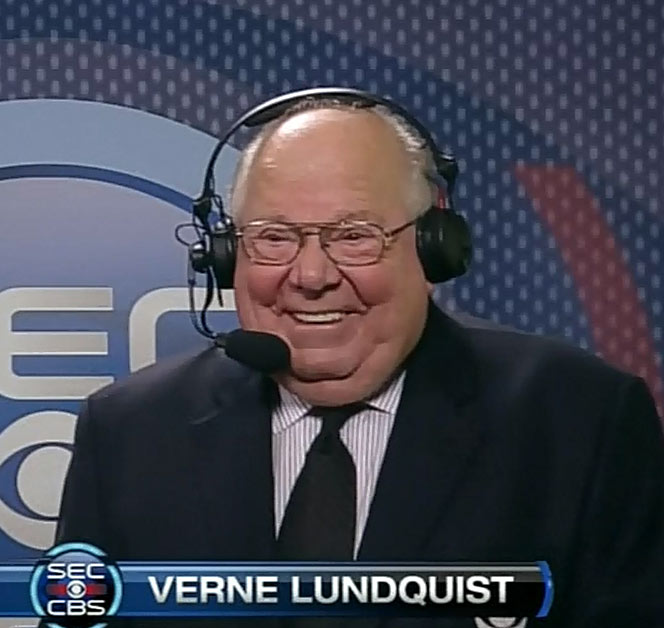
Greg: It’s been one of the best books in the genre for quite a while, so I felt it time to recognize that feat.

While Green Lantern Corps was the best Lantern book of 2013, 2014 belonged to the raging Reds. That’s no knock on the good work put in by Van Jensen and Bernard Chang (along with Robert Venditti and Billy Tan on Green Lantern), but Charles Soule and Alessandro Vitti took the Red Lanterns to heights previously thought unattainable for what started as a bit of a gimmicky book. At this point, we’re so far removed from the first year of Red Lanterns, which featured Atrocitus ruminating on the nature of rage each month, that it seems like a completely different series. One of the first steps Soule took to revamp the book was to recast Atrocitus as a villain, with everyone’s favorite rage kitty Dex-Starr as his sidekick, and to feature Guy Gardner the lead.
As Nick undoubtedly remembers, I was adamantly opposed to Gardner joining the Reds back in 2013. Much to my surprise, though, Soule and Vitti have given us a fresh take on Guy that still feels in line with the classic interpretations of the character. They’ve also given us the most consistently great team book in DC, one that made Zilius Zox, Bleez, Skallox, Ratchet and Rankorr into fan favorites by presenting them as equals with vastly different personalities who still work together for a common goal.
Vitti was a perfect fit for the book, as the best word to describe his art is “aggressive.” The anger bleeds off the page, and seeing Guy battle his own rage while managing that of his team formed the core of what became my favorite Corps of the year. The final knock-down drag-out fight between Guy’s Reds and Atrocitus’ Reds was perhaps the best action comic I read all year, and it certainly did the best job of stacking the odds against the protagonists. While Soule has left the title, I cannot recommend the trades enough. This was the book I looked forward to reading each month more than any other (save one) in 2014.
Nick: Couldn’t agree more. Soule took what we believed to be a terrible premise for a sagging title and completely proved us wrong. Major props to him and I’m very sad to see this book go.
Nick’s No. 1: Thor: God of Thunder
Greg: My biggest comics-related regret of the year was not catching up on God of Thunder. The recently-reviewed “Godbomb” is as far as I’ve gotten into the title, but there is no doubt of its greatness. Writer Jason Aaron and artist Esad Ribic have done a wonderful job crafting one of the great Thor tales in the character’s rich history.
Nick: Meet the new boss, same as the old boss. For longtime readers of the P2B comics section, you might remember that for our 2013 year-end awards, I picked Thor: God of Thunder as my top ongoing title. And while the greatest Thor series ever written may have shipped its final issue in 2014, it went out where it spent the entirety of its run: on top.
The majority of 2014 was taken up with the Last Days of Midgard story, which saw Thor’s newest human love interest, Roz Solomon enlist Thor’s help to battle the evil Roxxon corporation. Once Thor set himself against Roxxon, the company and its CEO, Dario Agger, responded by laying waste to the town of Broxton, Oklahoma. The battle that ensues brings back Ulik the troll for another knock-down, drag-out slobberknocker, bah Gawd, with the God of Thunder and also pits Thor against the mythical minotaur. This may all sound a bit hokey, but it truly provides some fantastic character development, as Thor learns that while he may be invulnerable, the people of Broxton and the rest of Midgard are not. For every strike he makes against Roxxon, people seem to suffer. Credit here goes to Aaron for continuing to fully explore a character that has been one-note under many less talented writers. And, of course, Aaron’s words would be nothing without the best Thor artist there ever has been — Esad Ribic. If Esad Ribic never did anything but draw Thor for the rest of his life, Marvel would have a lifelong customer in me.

But, in addition to the Last Days of Midgard, Aaron also delivered the finale to a damned fine Malekith story in the early parts of the year, wisely leaving the Dark Elf on the table to set up future stories and evil alliances to battle he (now she) who wields the hammer. In addition to the finale of that story, Aaron and Ribic also delivered one hell of a series finale in the epilogue to Last Days of Midgard. While it was billed as an epilogue, the issue stands perfectly well on its own, proving once again that Aaron may be the greatest writer of single issue stories going today.
The series has, sadly, come to an end, with a new Thor ongoing taking its place in November featuring the new female Thor as the main character while Thor Odinson is still there as a supporting character. However, Ribic did not accompany Aaron onto the new book, bringing an end to the finest partnership Asgard has ever seen. For 25 issues, the pairing gave me everything I can ask for from a Thor book. There were no lulls, not even a momentary lapse in quality. I’ve often been called a DC guy, but there’s no doubt in my mind that this Marvel book has been the best in comics for more than two years now. Kudos.
Greg: And while a Marvel book continued burrowing its way into your heart in the year that was, it was DC’s biggest seller that burrowed its way into my wallet even when funds were low.
Greg’s No. 1: Batman
Nick: Again, I’ve rambled way too long about the brilliance of Snyder and Capullo’s Dark Knight, so I’ll make way for Greg here.
Greg: What can be said about the now-more-than-three-year partnership between writer Scott Snyder and artist Greg Capullo? They’ve taken DC’s flagship character on a journey that is leaving instant classic story after instant classic story in its wake. As mentioned earlier, the phenomenal “Zero Year” molded Batman’s origin (and the origins of several key players in the character’s rich mythology) for a brand new generation. It gave us a dynamic new take on the Riddler that paid homage to Paul Dini’s work on “Batman: The Animated Series.” It introduced side characters along the way that will undoubtedly play a role in the Dark Knight’s future. It even managed to plow new ground on two of comics’ most written-about characters, Bruce Wayne and Alfred Pennyworth.
Along the way, there was a glimpse into the distant future of Batman Eternal, and then a jump-ahead past that event, the ongoing “Endgame” story. As if a faceless Joker (seen in 2013’s “Death of the Family”) wasn’t scary enough, Bruce’s archenemy kicked this story off by taking control of the entire Justice League!
Consistency is a rarity in comics these days. Creative teams often don’t even last the duration of a story arc, much less an entire year. The consistency of Snyder and Capullo being on this book for the last several years has resulted in a unity and clarity of vision. Never does it feel like the stories are escaping the creators’ grasp. The look, the feel, the sounds, the very existence of modern-day Gotham is defined by Snyder and Capullo in a way more defined than any since Miller’s formative work in the ’80s. It’s still too early to tell the long-term impact on future takes on Batman, but I have a strong sense that this run could inform future takes to almost the same degree that Miller’s work did back then. From 1987 through 2011, we essentially were reading different creators’ versions of Frank Miller’s Batman. In 10 years, we’ll be reading their versions of Scott Snyder’s Batman.
Nick: Couldn’t have said it better myself. Well, that about does it for this edition of Countdown. Be sure to be back next week when we delve into another trade paperback in The Longbook Hunters.
Greg: Ah yes, that old chestnut. As always, we welcome your feedback on Facebook, Twitter (@gphillips8652 and @nickduke87) or email (GregP@placetobenation.com and NickD@placetobenation.com). Let’s see your lists!
